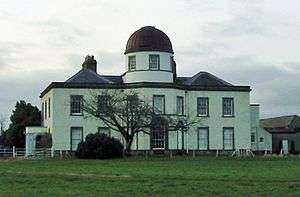Dunsink Observatory

The Dunsink Observatory is an astronomical observatory established in 1785 in the townland of Dunsink near the city of Dublin, Ireland.[1]
Its most famous director was William Rowan Hamilton, who, amongst other things, discovered quaternions, the first non-commutative algebra, while walking from the observatory to the city with his wife. He is also renowned for his Hamiltonian formulation of dynamics. In the late 20th century, the city encroached ever more on the observatory, which compromised the seeing. The telescope, then no longer state of the art, was used mainly for public 'open nights'.
Dunsink observatory is currently part of the Dublin Institute for Advanced Studies. It provides accommodation for visiting scientists and is also used for conferences and public outreach events. Public talks on astronomy and astrophysics are given regularly at the observatory by professional and amateur astronomers. Stargazing events are also held using the Grubb telescope.
History
The site was established on the south slope of a low hill in the townland of Dunsink, 84m above sea level.[2] The South Telescope or 12 inch Grubb, is a refracting (uses lens) telescope built by Thomas Grubb of Dublin, completed in 1868.[3] The achromatic lens, with an aperture of 11.75 inches, was donated by Sir James South in 1862, who had purchased the lens from Cauchoix of Paris 30 years earlier.[4] He had intended it for a large but troubled equatorial that came to fruition in the 1830s, but was dismantled around 1838.[5][6] (See also Great refractors)
The entry for the observatory in Thom's Directory (1850) gives the following account of the observatory,
| “ |
This Observatory, endowed by Francis Andrews, esq., LL.D., Provost of Trinity College, and erected in 1785, was placed, by statute, in 1791, under the management of the "Royal Astronomer of Ireland," an appointment first filled by Dr. Henry Ussher, and subsequently by Dr. Brinkley, Bishop of Cloyne. The Institution is amply furnished with astronomical instruments, and is open to all persons interested in astronomical science, on introduction to the resident Assistant. It is situated in Lat. 53° 23' 13" N., Long. 6° 20' 15" W.[1] |
” |
See also
References
- 1 2 Alexander Thom, Irish Almanac and Official Directory 7th ed., 1850 p. 258. Retrieved: 2011-02-22.
- ↑ Ordnance Survey Map. Select Wind Report for elevation. Retrieved: 2011-02-22.
- ↑ The South Telescope of Dunsink Observatory Authors: Wayman, P. A. Journal: Irish Astronomical Journal, vol. 8(8), p. 274 Bibliographic Code: 1968IrAJ....8..274W
- ↑ History of the Cauchoix objective
- ↑ "The Observatory of the Late Sir James South". Astronomical Register. 8: 196–199. 1870. Bibcode:1870AReg....8..196.
- ↑ Dictionary of National Biography, 1885-1900, Volume 53, "South, James", by Agnes Mary Clerke (WikiSource 2010)
Further reading
External links
Coordinates: 53°23′13″N 6°20′15″W / 53.387056°N 6.337547°W